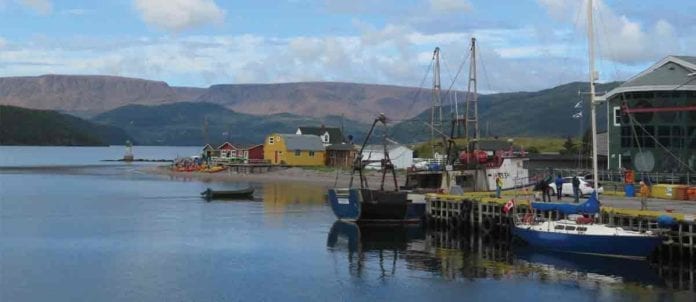A deserted beach on Newfoundland’s Avalon Peninsula isn’t most people’s idea of a grocery store. But within minutes, Lori McCarthy’s bag is filled with more than a dozen different edibles.
The founder of Cod Sounds leads foraging tours for visitors to Canada’s newest province, teaching them about the wild foods generations of Newfoundlanders have used to supplement their ocean-dependent diet. More significantly, McCarthy has become an important resource for restaurants in the province seeking local authenticity on their menus.
With late frosts and limited farming, trying to offer a local, sustainable menu in Newfoundland has left chefs with a dilemma. But, says McCarthy, who left her work as a chef to start Cod Sounds, “If you can’t grow it, why not use what the land naturally has to offer?” And, it turns out, this land is surprisingly rich in offerings.
Nicknamed ‘The Rock,’ Newfoundland is a mixture of bogs, barrens, rocky outcrops, mineral soil and water. Much of the island doesn’t easily support agriculture. Indeed, nothing at all grows on the iron- and mineral-rich rock of The Tablelands in Gros Morne National Park. This unique geological feature, a UNESCO World Heritage site, is some of the oldest rock on the planet — a spot where the earth’s mantle has actually pushed up through the outer crust.
McCarthy, a fourth-generation Newfoundlander, is determined to preserve her island’s culture and culinary history. With an armload of cattails and considerable moxie, she started her new enterprise by knocking on the door at Raymonds — a St. John’s restaurant internationally acclaimed by the likes of Wine Spectator, EnRoute and Diners Club. She acknowledges the apparent insanity, “But I thought to myself, if I could get the best chefs to use these things, I know they would do a good job. Then maybe others would follow.”
Raymonds’ chef Kyumin Hahn not only bought the cattails, but asked what else she could provide. “It became an awesome relationship,” says McCarthy. “He’s from Labrador and would show me pictures and ask if I could find these and I would show him plants and ask him whether he knew them. We learned from each other.”
She undoubtedly picked the right restaurant. Like McCarthy, Jeremy Charles, chef/co-owner of Raymonds, grew up in this province and knows its seasons intimately. “He was a trailblazer for putting local food on the plates,” McCarthy says. “He wanted everything to be as local as possible.” In Newfoundland, with its long history of foraging and ‘boil-ups’ — cooking outdoors over an open fire — local often means wild.
Charles, who honed his chef craft in Montreal and Chicago, is an enthusiastic fisherman and hunter. When he opened Raymonds with sommelier and partner Jeremy Dunia (the pair soon becoming known locally as ‘the two Jeremys’), he set about building relationships with a wide network of foragers, fishermen and hunters.
He encouraged local hunters to get licenses so they could legally sell moose and caribou and Raymonds is licensed to serve it, thanks to enlightened provincial laws. “This is one of the only places you can get real wild game,” says McCarthy. “In most places, it’s farmed.”
Sources such as McCarthy provide wild game — grouse, hare and moose — as well as foraged foods such as wild berries, chanterelles, nettles and more. These were traditional fare for hardy Newfoundlanders and reviving these traditions has not only provided income for many in an oft beleaguered provincial economy, but also created a menu that has been hailed as truly authentic when it comes to representing terroir.
At Fogo Island Inn, an extraordinary range of foraged and wild fare can be found in an ever-changing menu. The resort, which has brought prosperity to this tiny island, has become the darling of glitterati such as Gwynneth Paltrow, who tweeted her enthusiastic approval. Perched on the edge of the island with extraordinary, wide-ranging views of whales, icebergs and Atlantic Ocean waves, an innovative and stubbornly local menu is an enormous part of the appeal.
“I rely on pickers for a wide variety of mushrooms and berries and local fishermen provide fish and seafood,” says chef Timothy Charles (no relation to Jeremy). “The kitchen staff goes out, too, to collect plants like dandelions, nettles, sea rocket and juniper.”
Newfoundland boasts a growing list of chefs across the province cooking with ‘what we have to hand.’ Giving the term ‘local’ a whole new meaning, it’s been fondly dubbed Rustic East Coast cuisine, but the sophistication of these chefs belies this simplified appellation.
For example, in 2013, chef Todd Perrin opened Mallard Cottage in the harbour-side community of Quidi Vidi, near St. John’s. Perrin’s unique take on traditional Newfoundland fare includes dishes such as cod napes (necks) with a molasses-cider glaze served with wild chives, or freshly caught halibut paired with locally foraged chanterelles and wild greens. Applauded by locals as well as visitors, a reservation is essential to dine at this deceptively casual spot.
In Corner Brook, another native son, Kevin Vincent, is the man wielding the knife at Newfoundland Sushi. But you won’t find these versions on any Japanese menu. The names are pure Newfoundland: Humber River Roll, Bay of Islands Roll, Blow Me Down Roll. And, naturally, the traditional Japanese sushi boat is replaced with the Dory Load of Sushi.
At Chinched Bistro (chinched in the local dialect means full to bursting), Michelle LeBlanc and Shaun Hussey have won awards for promoting Newfoundland fare. The seasonal menu always features their own celebrated charcuterie and fried pig ears made from locally raised pork, as well as cod — once Newfoundland’s main source of income. These are augmented by seasonal treats such as capelin, foraged chanterelles, bakeapples (cloudberries) and partridgeberries. Indeed, the idea for their restaurant came after a traditional beach boil-up on Fogo Island, which left them ‘chinched.’
No discussion of food in this province can ignore the boil-up. It isn’t elegant dining, but there’s nothing quite as satisfying as mussels straight out of a pot bubbling over an open fire with “just a drop of sea water” — the traditional Newfoundland recipe for a beach boil-up.
On the beach with McCarthy, the boil-up starts with a cup of wild-mint tea. Thin slices of fresh sweet scallops are just warmed through on a hot rock over the flames and given a gourmet touch with tiny wildflower blossoms. Tiny carrots sizzle in a frying pan and strips of wild moose are grilled over the flames on a skewer of sweet gale. Pickled bakeapples and beets, prepared the day before, accompany this feast. Fresh cod might also be cooked en papillote in pieces of sugar kelp and McCarthy often dons a wetsuit to collect fresh sea urchins and periwinkles for her guests.
At Lobster Cove Head Lighthouse in Rocky Harbour, a National Parks Canada site in Western Newfoundland, Ian Stone leads another foraging tour. He and partner Rebecca Brushett run A Taste of Gros Morne, leading hikes through the area, which include tastings from the wild.
Brushett also brings visitors to local restaurants and inns in a progressive taste tour of uniquely Newfoundland food. “Some of the best places to eat here are the inns. They don’t advertise their restaurants because they don’t necessarily want a big crowd,” says Brushett. “These may be small spots but the food is incredibly creative and I want visitors to try it.”
A good example is an inspired pairing of scallops with grenadine syrup at Madison’s at Marble Inn Resort. Here, chef Arafat draws on his own culinary culture to create dishes such as this and halibut with a white-bean cassoulet, chorizo and arugula salad.
When not in the kitchen at Blue Ocean — the dining room at Bonne Bay Inn — chef Jason Nesbitt, who “comes from away” (a Newfoundland expression for those not born there), heads outdoors and does his own foraging. Here, too, the menu often includes an exotic twist on Newfoundland ingredients with dishes such as lobster dumplings or moose samosa.
“It’s okay to create new traditions with old foods we’ve eaten for centuries,” says McCarthy. The goal is to ensure that these old food sources and the ability to find and use them isn’t lost on future generations.”
Written by Liz Campbell


















